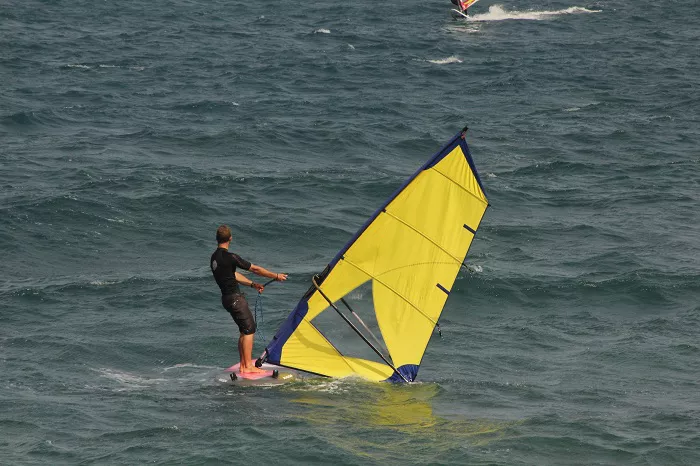Windsurfing is an exhilarating water sport that combines elements of sailing and surfing, attracting adventure seekers from around the world. However, as with any extreme sport, it comes with inherent risks. Many beginners and even experienced windsurfers often wonder: Is windsurfing dangerous?
In this article, we will explore the potential dangers associated with windsurfing, factors that influence its risks, and practical safety measures to ensure an enjoyable and secure experience.
Understanding the Risks of Windsurfing
1. Physical Injuries
Like any action-packed sport, windsurfing poses a risk of physical injuries. These injuries can range from minor bruises to more severe conditions such as fractures, dislocations, and muscle strains.
Impact Injuries: High-speed falls into the water can cause sprains or fractures, especially if the sailor lands awkwardly or collides with the board.
Overuse Injuries: Continuous sailing can lead to repetitive strain injuries, particularly in the shoulders, back, and knees.
Cuts and Abrasions: Contact with the board’s sharp fins or submerged objects can result in cuts and bruises.
2. Drowning Risks
While windsurfing mainly takes place on the water’s surface, the risk of drowning is present, particularly for those who lack strong swimming abilities.
Getting tangled in the rigging or sail can make resurfacing difficult.
Sudden changes in wind conditions can make self-rescue challenging.
Fatigue and exhaustion in deep waters increase the drowning risk.
3. Weather and Environmental Hazards
Windsurfing is highly dependent on weather conditions, making it crucial to assess potential environmental dangers before heading out.
Strong Winds and Storms: Sudden wind gusts or changing weather patterns can make navigation difficult and increase the chance of losing control.
Large Waves and Rough Seas: Unpredictable water conditions can capsize windsurfers or push them away from shore.
Hypothermia and Sun Exposure: Cold water and prolonged exposure to sunlight can cause hypothermia or sunburns, particularly in extreme conditions.
4. Equipment Failures
A windsurfing board and rig consist of multiple components, any of which can fail unexpectedly.
Sail Malfunctions: Tears or damage to the sail can reduce control over the board.
Broken Mast or Boom: Equipment failure can leave windsurfers stranded far from shore.
Leash and Harness Issues: A snapped harness line can result in sudden falls or difficulty maneuvering.
5. Marine Life Encounters
Depending on the location, windsurfers may encounter marine creatures such as jellyfish, sharks, or sea urchins.
Jellyfish stings can cause pain and allergic reactions.
Collisions with large marine animals can be startling or hazardous.
Sea urchin spines can penetrate the skin if stepped on in shallow waters.
How to Minimize the Risks of Windsurfing
1. Use Proper Safety Gear
Wearing appropriate protective equipment can significantly reduce the risks associated with windsurfing.
Life Jacket or Personal Flotation Device (PFD): Essential for buoyancy in case of falls.
Helmet: Protects against head injuries, especially in strong winds or crowded areas.
Wetsuit or Drysuit: Helps prevent hypothermia in colder waters.
Water Shoes: Provide protection against sharp objects and slippery surfaces.
2. Check Weather Conditions Before Sailing
Understanding wind and water conditions is vital for safe windsurfing.
Avoid heading out in stormy or high-wind conditions unless experienced.
Check for rip currents, tidal movements, and offshore winds.
Use weather apps or consult local forecasts before sailing.
3. Know Your Limits and Skill Level
Progressing at a steady pace and acknowledging skill levels can prevent unnecessary risks.
Beginners should stick to calm waters and practice close to the shore.
Avoid pushing beyond comfort zones in choppy or open-sea conditions.
Take lessons from certified instructors to learn the fundamentals properly.
4. Stay Aware of Surroundings
Situational awareness is key to avoiding collisions and accidents.
Keep an eye on other watercraft, swimmers, and fellow windsurfers.
Be mindful of hazardous underwater structures or reefs.
Choose locations with designated windsurfing zones for added safety.
5. Use Well-Maintained Equipment
Regular equipment checks can prevent unexpected malfunctions.
Inspect the sail, mast, and boom for signs of wear and tear.
Ensure foot straps and harness lines are secure and functional.
Carry a safety whistle or communication device for emergencies.
6. Learn Self-Rescue Techniques
Understanding how to recover from falls or difficult situations is essential.
Water-starting techniques can help recover the board in deep waters.
Upwind sailing skills can assist in returning to shore safely.
Practice releasing yourself from tangled rigging swiftly.
Conclusion
Windsurfing, like any adventurous sport, carries inherent risks, but with proper preparation, training, and safety measures, these risks can be minimized. Many enthusiasts find windsurfing to be a thrilling and rewarding activity, provided they follow precautions and respect the power of nature.
While accidents can happen, most risks are manageable with the right approach. By wearing appropriate gear, choosing safe conditions, and continuously improving skills, windsurfing can be both an exciting and relatively safe water sport.

